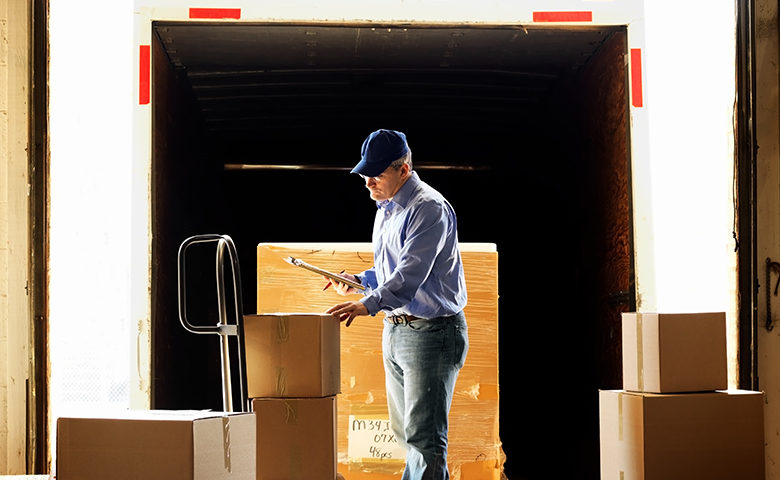There are several common loading dock hazards that deserve attention, but one of the biggest ones is trailer separation. This is when a trailer unexpectedly moves away from a dock. It can cause people and forklifts to fall in the gap, get crushed by suddenly moving materials or forklifts, or be struck by the trailer.
The primary causes of trailers moving away from a dock include:
- drivers unexpectedly pulling away,
- the weight of forklifts, movement of materials, and failure of landing gear, or
- wheel chocks failing or being used ineffectively for a variety of reasons.
There are additional causes for trailer separation, many of which are context specific, and precautions need to be taken to prevent all of the possible scenarios. It’s worth noting that no single solution will guarantee safety and a variety of methods should be used in combination to protect employees and materials being moved.
Below is a rundown of the major steps that organizations can take to improve their loading dock safety.
Main precautions
Restraints and locking systems
It’s important to restrain and secure trailers to docks, and ensure that the landing gear is in working order. Automatic restraints that hook into the rear impact guard can provide a great deal of security.
But because of differences in trailers (some, for example, don’t have ICC bars), wheel-based vehicle restraints might also be useful as they will work with all types of trucks. In general, top-quality vehicle restraints and locking systems should be considered and, ideally, organizations should aim to secure trucks to the loading docks from both sides, top and bottom.
Wheel chocks
Wheel chocks should be an additional safety measure and not the only solution to the problem of trailer separation. That’s because they’re much less effective on wet surfaces, snow and ice, and drivers can easily pull over the chocks despite them being in place. Wheel chocks are also sometimes misplaced or lost, and having them as an additional safety measure rather than the primary one is the best solution.
Dock plates
Sometimes, a small gap or a difference in levels between the dock and the trailer are inevitable, which is why a dock plate is a valuable safety feature. However, employees should know not to become complacent with it, and they should always check it prior and during use to ensure that it is secure, won’t be a tripping hazard, and that it can support the load safely.
Weight distribution
Sudden changes in weight (for example, when the weight of the forklift in the back of the trailer causes the front of the trailer to pop up, or vice versa) can cause everything in the trailer to move away from the raised end, putting everyone in the way at serious risk. Positioning of the rear tandems is very important. Trailer jacks should also be considered to avoid upending.
Forklift safety
Organizations need to ensure that their employees are certified and that they operate the forklifts safely. It’s easy for people to become complacent or rush through loading and unloading procedures, but drivers should always take all the precautions necessary and drive safely.
Inspections and maintenance
Every piece of equipment needs to be inspected regularly, including forklifts, restraints, landing gear and dock plates. If anything could potentially fail in any way, it needs to be regularly inspected and, if needed, replaced. This is a vital part of any smoothly functioning operation and should not be taken lightly.
Communication
Depending on the situation, time of day, size of materials being shipped, and even the light levels, lines of sight can be obstructed and visual communication can be challenging. Therefore, effective communication among the team, and between the team and the driver, is vital. This very much relies on the company safety culture and requires a strong sense of teamwork and a common safety language.
Landing gear failure
This problem deserves its own section, because when landing gear underneath a truck collapses, it doesn’t only separate from the dock—the whole trailer can pitch forward or fall over. If workers are inside or anywhere nearby when this happens, they can be seriously injured or killed.
Organizations should not only ensure that they invest in top-quality landing gear (and additional fixed jacks and trailer stands, just in case), but they should also make sure that the equipment is regularly inspected and maintained. If it’s ever damaged or there is any doubt as to its performance, it should be immediately replaced.
Employee safety
Trailer separation and collapse contributes to multiple employee and forklift incidents every year. It poses risk to workers and property, so investing in preventative measures is a must. But employers should not forget about training. If workers perform dock leveler maintenance without following LOTO rules, if they don’t drive their forklifts safely, or if they don’t communicate clearly with each other and with the drivers, engineering solutions will not be enough.
The tools are only as safe as the people using them. Organizations should remember that offering engaging and thorough training will help employees keep their mind on task, be mindful of their own behavior around hazards, and keep an eye out for their colleagues’ safety. And leaders should always lead by example. If they exhibit safe behaviors and always follow the regulations regardless of the situation, their employees will be more likely to follow suit.

